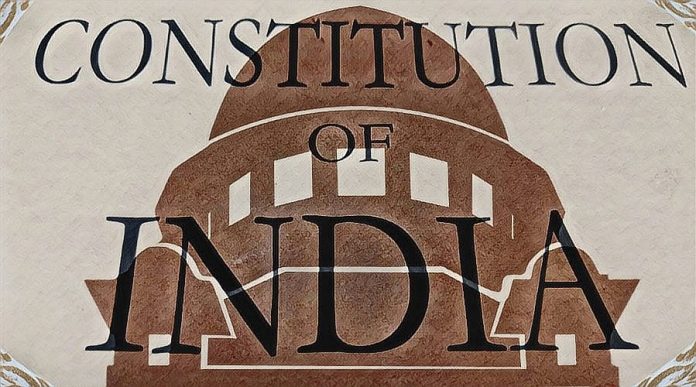

The Constitution of India provides various rights to the citizens of India. One of the most essential rights for the intellectual and moral development of citizens of India are fundamental rights. These rights are mentioned under Part – III of Indian Constitution including rights to equality, right to freedom, right against exploitation, right to freedom of religion, cultural and educational rights and right to constitutional remedies. Merely stating these rights under the constitution and providing them to the citizens of India is not sufficient. It is required that these rights should be protected.
In order to protect these essential rights, Article 32 and Article 226 of the Indian Constitution provides remedies and enforcement of rights mentioned under Part – III. Article 32 and Article 226 provides the right to move to the Supreme Court and the High Court respectively through appropriate proceedings. This right can be availed by any person whose fundamental rights are violated.

A writ means an order that is issued under an authority. Therefore, a writ can be understood as a formal order issued by a Court.
A writ petition is an application filed before a Court, requesting to issue a specific writ.
The Constitution of India, under Article 32 and Article 226, provides five types of writs to the citizens of India. These writs have different meanings and applications. They are:
The term habeas corpus means ‘you may have the body of’. This writ can be used when a person is illegally detained. By the use of this writ, the court directs the person detained to be brought before the court to examine the legality of his detention.
A writ of habeas corpus can be filed under the following circumstances:
Recently, the writ of habeas corpus was used by Republic TV Editor-in-chief Arnab Goswami before Bombay High Court, challenging his arrest in the case of abetment to suicide.
The writ of habeas corpus cannot be filed under the following circumstances:
In the case of Sunil Batra vs Delhi Administration, 1980 , the Supreme Court expanded the scope of habeas corpus to the prisoners against inhumane treatment by the jail authorities. It was held in this case, that the court has the power and responsibility to protect the prisoners against this crude behaviour and can use habeas corpus writ to enforce in prison humanism.
The term mandamus means ‘we command’. It is generally a command which is issued by the court to a public servant asking him to perform his duty, which he has failed to do so. The writ of mandamus can also be issued against a corporation, an inferior court or a government body for the same reason, i.e., they failed to perform their official duties.
There are certain circumstances under which writ of mandamus cannot be filed:
The term certiorari means ‘certified or to be informed’. It is generally issued by a higher court to a lower court either to transfer the pending case to a higher authority or squash the judgement passed. In the year 1991, the Supreme Court ruled that the writ of certiorari can also be issued against administrative authorities if their judgements are violating the rights of an individual.
In the case of Hari Vishnu vs Ahmed Ishaque, 1995 , the court held that an error in the decision or determination itself may also be amenable to a writ of “certiorari” if it is a manifest error apparent on the face of the proceedings.
The writ of certiorari can be issued under the following conditions:

The term prohibition simply means ‘to forbid’. The writ of prohibition can only be issued against judicial and quasi-judicial authorities. This writ is generally not available against administrative authorities and private individuals.
It can be issued against a lower court or by a superior court to forbid the act which is performed outside its jurisdiction at any stage of its proceedings.
The term quo- warranto means ‘by what authority or by what warrant’. It is generally issued by a court to enquire the legality or under what authority he is holding that office. It prevents the illegal holding of a public office by any person.
The writ of quo- warranto cannot be issued against:
This writ cannot be issued in the case of a ministerial office or private office.

A writ petition can be filed by any individual whose fundamental rights, mentioned under Part – III of the Indian Constitution, are violated. It is a protection against the infringement of fundamental rights.
The application of the writ of Habeas Corpus can be filed by a prisoner who is detained and also by his/her friends or relatives. It is considered as a power that can force the court to address the officer who detained the prisoner. If the court finds that the officer is acting beyond his authority, then the court can order to release the prisoner.
The writ petition, for the violation of fundamental rights, can be filed either in the High Courts or in the Supreme Court. Under Article 32, a person can file a writ petition in the Supreme Court for the violation of his/her fundamental rights.
Under Article 226 , a person can move to the High Courts to file a writ petition when there is a violation of his/her fundamental rights. It should be noted that the authority against whom the writ petition is filed has to be present within the territory of India, otherwise, the petition has no value.
When a person’s fundamental rights are infringed, he can move to either of the courts. It is not necessary to first move to the High Court and then to the Supreme Court.
In the case of Rajmata Vijai Raje Scindia vs State of Uttar Pradesh, 1986 it was held that there is no specific time limit to file a writ petition in India but it is expected that it should be filed without any delay. In case there is a delay, the court asks for valid justification for the delay. Hence, a reasonable delay is justified, otherwise, the petition may be dismissed.
To file a writ petition in either of the courts, a specific procedure needs to be followed:
Firstly, the aggrieved party has to approach a particular organization with necessary documents like identity proof, residential proof, photographs etc.
Then there is the drafting of the petition with help of a lawyer. The draft includes the name and address of the aggrieved party along with the facts that lead to the violation of his/her fundamental rights.
After this process, the draft of the petition is sent to the court.
Then the date of hearing will be set and on this date the court accepts the petition and generates a notice to the other party. After this, a date is given to assure the presence of both the parties.
Finally, after hearing both the parties, the court gives judgement and grants relief accordingly.
WRIT OF HABEAS CORPUS
In the High Court of Judicature at ________
Writ Petition No._________
Under Article 226 of the Constitution of India
……………RESPONDENTS
The Hon’ble Chief Justice and His Companion Judges of the aforesaid Court.
The humble petition of the petitioner above named respectfully showeth:
WRIT OF MANDAMUS
IN THE HIGH COURT OF…………………… AT……………………
CIVIL ORIGINAL (EXTRA-ORDINARY) JURISDICTION
CIVIL WRIT PETITION NO…………………… OF 200…
IN THE MATTER OF:
May it please the Hon’ble Chief Justice of the High Court of…………………… and His
Lordship’s companion Judges.
THE PETITIONER MOST RESPECTFULLY SHOWETH:
PETITIONER THROUGH COUNSEL
WRIT OF CERTIORARI
IN THE HON’BLE HIGH COURT AT_________
(Original Civil Jurisdiction)
Writ Petition No_______
PETITION UNDER ARTICLE 226 OF THE CONSTITUTION FOR THE ISSUE OF A WRIT OF CERTIORARI.
The Hon’ble the Chief Justice and his companion Judges of the Hon’ble High Court of ___________
The above-named Petitioner begs to submit as under:
WRIT OF PROHIBITION
IN THE HON’BLE HIGH COURT OF JUDICATURE AT_________
Writ Petition No_________ of _________20 _________
PETITION UNDER ARTICLE 226 OF THE CONSTITUTION FOR THE ISSUE OF A
WRIT OF PROHIBITION.
The above-named Petitioner begs to submit as under:
WRIT OF QUO–WARRANTO
IN THE HON’BLE HIGH COURT OF JUDICATURE AT _________
(Original Civil Jurisdiction)
Writ petition No.________ of ________ 20_______
PETITION UNDER ARTICLE 226 OF THE INDIAN CONSTITUTION FOR THE ISSUE OF THE WRIT OF QUO WARRANTO.
The Hon’ble Chief Justice and his companion Judges of the Hon’ble High Court.
The above-named Petitioner begs to submit as under:
(Counsel for Petitioner)
IN THE SUPREME COURT OF INDIA
ORIGINAL JURISDICTION
CIVIL WRIT PETITION NO._________OF 20_________
IN THE MATTER OF
………… PETITIONER
………… RESPONDENTS
PETITION UNDER ARTICLE 32 OF THE INDIAN CONSTITUTION FOR ISSUANCE OF THE WRIT IN THE NATURE OF _________ UNDER ARTICLE _______ OF THE INDIAN CONSTITUTION.
The Hon’ble Chief Justice of India and his Lordship’s Companion Judges of the Supreme Court of India. The humble petition of the petitioner above named.
MOST RESPECTFULLY SHEWETH:
That the present petitioner has not filed any other petition in any High Court or the Supreme Court of India on the subject matter of the present petition.
In the above premises, it is prayed that this Hon’ble Court may be pleased:
FOR WHICH ACT OF KINDNESS, THE PETITIONER SHALL AS IN DUTY BOUND, EVER PRAY.
PETIONER-IN-PERSON
The writ petition should be accompanied by:
Our constitution provides us with various rights. Some of the most important rights provided by our constitution are Fundamental rights. As the name suggests, these rights are essential for individual development. Since rights are available, their infringement is possible. So in order to protect these rights, we have five types of writs which a person can file before a High Court or the Supreme Court under Article 226 and Article 32 respectively.
LawSikho has created a telegram group for exchanging legal knowledge, referrals and various opportunities. You can click on this link and join:
Follow us on Instagram and subscribe to our YouTube channel for more amazing legal content.